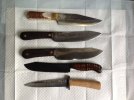- Joined
- Aug 2, 2017
- Messages
- 3,121
Citing as examples BK series, Esse.... these knives are much wider regardless of length than most bushcraft, edc, fighters...pretty much every other knife style roughly speaking. Another class of wide knives are chef's knives which I believe is useful for moving piles of chopped food around a cutting board or at least that's my observation.
So what are the benefits of wide blades?.
So what are the benefits of wide blades?.

